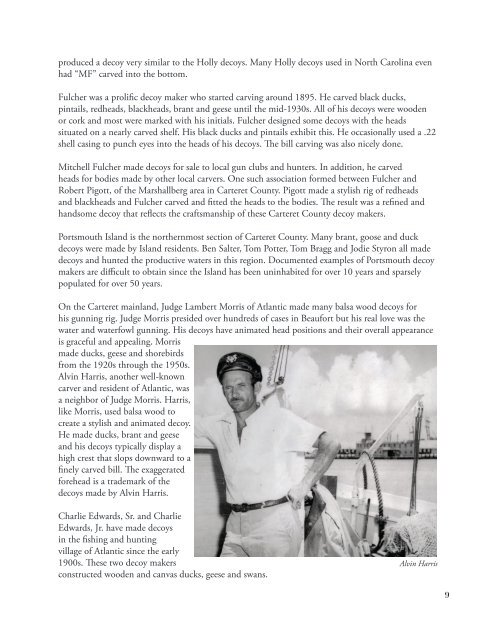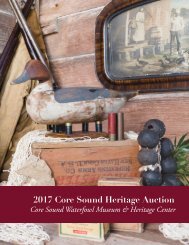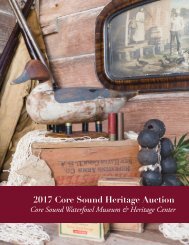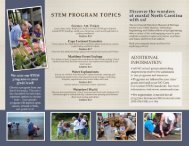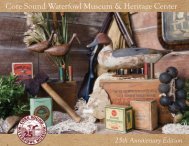Heritage Auction Final Digital 11-17
You also want an ePaper? Increase the reach of your titles
YUMPU automatically turns print PDFs into web optimized ePapers that Google loves.
produced a decoy very similar to the Holly decoys. Many Holly decoys used in North Carolina even<br />
had “MF” carved into the bottom.<br />
Fulcher was a prolific decoy maker who started carving around 1895. He carved black ducks,<br />
pintails, redheads, blackheads, brant and geese until the mid-1930s. All of his decoys were wooden<br />
or cork and most were marked with his initials. Fulcher designed some decoys with the heads<br />
situated on a nearly carved shelf. His black ducks and pintails exhibit this. He occasionally used a .22<br />
shell casing to punch eyes into the heads of his decoys. The bill carving was also nicely done.<br />
Mitchell Fulcher made decoys for sale to local gun clubs and hunters. In addition, he carved<br />
heads for bodies made by other local carvers. One such association formed between Fulcher and<br />
Robert Pigott, of the Marshallberg area in Carteret County. Pigott made a stylish rig of redheads<br />
and blackheads and Fulcher carved and fitted the heads to the bodies. The result was a refined and<br />
handsome decoy that reflects the craftsmanship of these Carteret County decoy makers.<br />
Portsmouth Island is the northernmost section of Carteret County. Many brant, goose and duck<br />
decoys were made by Island residents. Ben Salter, Tom Potter, Tom Bragg and Jodie Styron all made<br />
decoys and hunted the productive waters in this region. Documented examples of Portsmouth decoy<br />
makers are difficult to obtain since the Island has been uninhabited for over 10 years and sparsely<br />
populated for over 50 years.<br />
On the Carteret mainland, Judge Lambert Morris of Atlantic made many balsa wood decoys for<br />
his gunning rig. Judge Morris presided over hundreds of cases in Beaufort but his real love was the<br />
water and waterfowl gunning. His decoys have animated head positions and their overall appearance<br />
is graceful and appealing. Morris<br />
made ducks, geese and shorebirds<br />
from the 1920s through the 1950s.<br />
Alvin Harris, another well-known<br />
carver and resident of Atlantic, was<br />
a neighbor of Judge Morris. Harris,<br />
like Morris, used balsa wood to<br />
create a stylish and animated decoy.<br />
He made ducks, brant and geese<br />
and his decoys typically display a<br />
high crest that slops downward to a<br />
finely carved bill. The exaggerated<br />
forehead is a trademark of the<br />
decoys made by Alvin Harris.<br />
Charlie Edwards, Sr. and Charlie<br />
Edwards, Jr. have made decoys<br />
in the fishing and hunting<br />
village of Atlantic since the early<br />
1900s. These two decoy makers<br />
constructed wooden and canvas ducks, geese and swans.<br />
Alvin Harris<br />
9<br />
heritage auction 2.indd 9<br />
<strong>11</strong>/<strong>17</strong>/<strong>17</strong> <strong>11</strong>:46 AM


